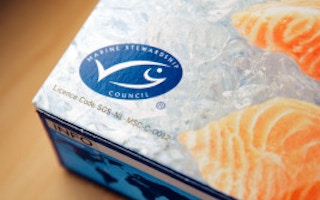The number of sustainable fish and seafood products on Australian supermarket shelves has more than doubled in the past year, as consumers increasingly demand to know where and how their seafood has been caught.
The Marine Stewardship Council, the international non-profit organisation that manages the distinctive blue labelling system that identifies sustainable fish, says there are now more than 120 sustainable seafood products in Australia.
Last year there were fewer than 60 products available in Australia.
Patrick Caleo, the council’s Australian manager, said retailers were increasingly keen to sell sustainable seafood products.
He said Coles and Woolworths last year committed to a sustainable seafood sourcing policy to increase the number of council products on their shelves, while Aldi already sells 30 council-certified products.
Mr Caleo said interest in sustainable products had grown rapidly in the past 18 months in Australia, Europe and the US.
There are now about 13,000 products that use the council’s blue eco-label being sold in 80 countries, Mr Caleo said.
”There has definitely been a lot of interest in the [council] program, especially large corporate interest,” Mr Caleo said.
Council-labelled products include canned and frozen hake, hoki, red and pink salmon, albacore tuna, herring and sardines, and are sold by leading brands including John West, Birds Eye, Pacific West, Talley’s and supermarkets’ private labels.
There are also almost 40 council-labelled sustainable products that are sold in commercial cartons to restaurants and cafes and four Australian fisheries have been certified by the council, with another three undergoing full assessment.
The director of the Australian Marine Conservation Society, Darren Kindleysides, said there was no doubt that consumers were very concerned about where and how their seafood was caught and wanted to buy sustainable products.
”The sustainable seafood movement has been the fastest moving food movement,” Mr Kindleysides said.
”People are much more conscious of the impact they are having on the ocean so chefs and restaurants are wanting to use sustainable seafood and the supermarkets are getting more and more questions about the products they stock.”
The largest branded supplier of seafood in Australia, John West, has committed to ensuring all its products are sustainable by 2015. John West has a new sustainable seafood partnership with the world’s largest conservation organisation, the WWF.
Stuart Stirling, the marketing manager for John West, said the company wanted to ensure consumers could make informed decisions about what they bought.
”There has been an increase in the level of awareness from consumers but to be honest that is not the motivation behind why we have taken this step with WWF,” Mr Stirling said.
”Really as the largest branded seafood supplier in Australia and New Zealand we really feel it is our responsibility to do the right thing by the oceans and of course we do want to make sure we have a sustainable business into the future.”










